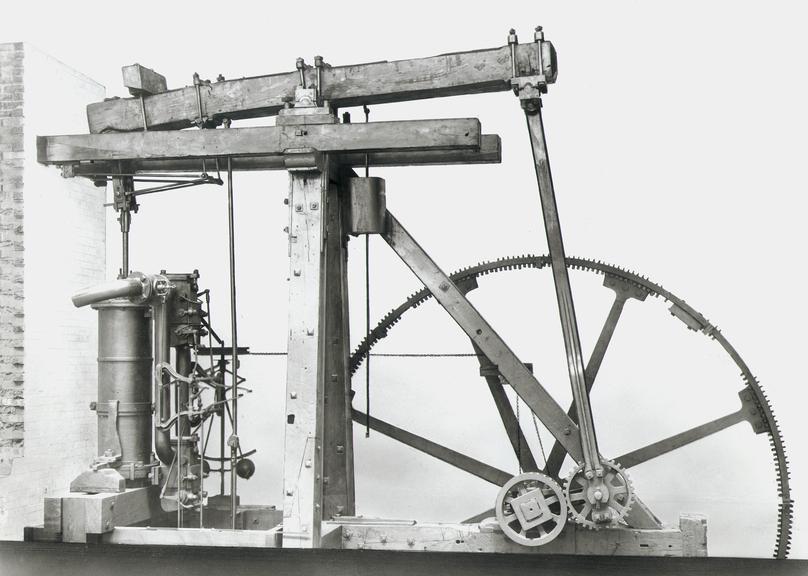Bringing the chemical industry into the 21st century.

The past and the future of chemistry as we know it.
In 1776, chemist and mechanical engineer James Watt invented the Watt steam engine, which was fundamental to the changes brought by the Industrial Revolution. Ever since – and potentially even before – an understanding of chemistry has been the foundation for our technological development, and there is no reason to believe that this holds any less true for the future. Whether we need more sustainable materials or biodegradable fuel to reduce our carbon emissions, new materials allowing us to travel to space or terraform Mars, novel ways of ensuring that every person on this planet is properly fed or understanding how we can handle an ocean filled with plastic particles, chemistry is going to be absolutely foundational.
What has enabled such a thorough understanding of chemistry pertains to the field’s formalism – the same as for maths and physics. This means structured approaches to unifying language so that any chemist anywhere can talk about anything from the basic elements, via molecular formulas to complex synthesis procedures in the same way. This structured way of communicating with each other has allowed rapid progress in this scientific field.
However, formalism has its downsides: when you simplify a process or a thought process into a unified language, inevitably there will be a loss of information on the way. Much like a compressed image is easier to share and still shows the same motive, but is pixelated, so can formalist research results be easier to convey, transmitting a general idea of the approach, whilst missing the finer details. Ideas are compressed to formulas, long research papers compressed to abstracts, novel ideas compressed to a 140 character tweet, detailed lab notes compressed to summaries.
In chemical research, this ‘compression’ has been required because of human limitation – but today, it isn’t required anymore. Computers have already allowed a much broader and larger volume of shared knowledge – which in itself makes absolute formalism tricky. And thanks to advances in AI, we are rapidly approaching a new frontier for research.
With new AI advances, machines can help researchers find what other researchers have done, ‘translate’ it into that researchers’ current context, and get a much higher clarity on how and why the solutions or conclusions were reached – without the information loss built into the current process. The machine will have all the necessary information–as there is no information loss–to communicate or ‘translate’ the exact relevant pieces between the researchers. This will truly be a new paradigm of chemical research (and beyond).

The chemical industry is trying to solve a 21st-century problem with a 20th-century approach
The state of scientific knowledge today is as if we had millions of cities (knowledge nodes) but only small footpaths through the woods to connect them – and no reliable map. However, with recent advances in AI technology, we are now able to build some serious digital highways, connecting all these ideas and people.
Discovering scientific insights about a specific topic is challenging, particularly considering that chemistry is one of the top-five most published fields with over 11 million publications and 307,000 patents. Moreover, the pace at which worldwide scientific knowledge expands is staggering. In 2016 alone, almost 2.2 million scientific articles were published and this output is doubling every nine years. In the process of trying to navigate, extract information from, and understand all this material, simplifications are being made and too much information is lost or missed. This is hampering global progress, and frustrating both the individual researchers trying to wrangle all this information and their R&D managers responsible for the department delivering quality commercially feasible results.
We have reached a point where a researcher will know that the answer they are looking for is likely to be ‘out there somewhere’, but there is no way for them to find it. The reasons for this include:
a) there is not one table in one location where all the information one might need is stored;
b) researchers are no longer able to adhere strictly to the previously helpful formalist rules as interdisciplinarity and creativity is (or should be) the new norm;
c) no-one documents and disseminates information in the exact same way; and, at the end of the day,
d) there is simply too much knowledge for a human researcher to assimilate.
This causes major challenges in finding the right knowledge, whether the answer is a quick and simple one (“what other applications are there for my compound?”) or way more complex (“if we extract the knowledge from these three papers, these ten patents, and this product sheet… doesn’t that mean we have an entirely novel compound?”).
Chemical companies need to:
a) find ways to utilise their core competencies and existing knowledge to generate new revenue,
b) reduce the risk of lab experiments failing by having as much upfront information as possible, and
c) make their R&D process as cost-efficient as possible without compromising quality.
The best way to go about the first two challenges is leveraging existing scientific literature, but unfortunately, that is not possible today while at the same time achieving the latter.
Chemical companies’ R&D departments today are absolutely vital to the companies’ survival and ongoing success, but they are at the same time seen as a non-revenue generating “burden”: Necessary, but expensive. Very expensive.
Chemical companies’ R&D departments today are absolutely vital to the companies’ survival and ongoing success, but they are at the same time seen as a non-revenue generating “burden”: Necessary, but expensive. Very expensive. R&D managers are under pressure to deliver more results, faster, but because of the overwhelming amount of information, it is becoming increasingly difficult. At the same time, their most valuable R&D assets are their research staff, to whom searching through thousands of documents to try to find answers is just an annoying and tedious burden, far removed from the real fun work that happens in the lab. And the less the researcher reads in advance, the higher the chances are their lab experiments may fail, wasting their time and the company’s valuable budget.

Out of an average of 1,800 hours worked every year, studies show that about 40% of a chemistry R&D researcher’s time is currently spent between finding (19%), reading (11%) and organizing (10%) existing literature. This represents a massive inefficiency.
To remain competitive and grow their market share, chemical companies need to constantly ask themselves the questions listed below, and efficiently find their answers from existing literature (something not fully possible today, based on the current state of affairs, including the productized available technology):
- What are new uses for an existing compound?
- How can we change the properties of an existing material?
- What other synthesis pathways will improve our existing manufacturing process?
- What compounds with specific properties can be used as substitutes in an existing application area?
- What new chemical substances can we create by combining known compounds, and thus a new market?
- Of all of the above questions, what approaches are more sustainable, as we are under continued pressure to reduce our environmental footprint?
The only way for industrial chemists to potentially find answers is relying on limiting keyword-based search engines, summarized findings that ‘everyone’ has access to and following key researchers on social media channels to see what they are up to. After that, no matter how the papers are found, they still need to manually screen and review existing chemical literature one paper at a time. But as we have shown above, this is a very challenging task with very slim chances of finding what is needed. And even if they should be diligent and have a large enough team to be able to stay on top of existing literature – they can not also have time to crunch the findings, test the knowledge, validate the hypotheses in the lab and then publish the results as well. This means that, based on the current state of existing knowledge management solutions, there is very little time for actual innovation. Chemists then have no other alternative, but to rely on their own experience, limited knowledge, rules of thumb, outdated tools and the occasional dumb luck. Moreover, ‘blind’ trial and error leads to repeatable, mundane and time-consuming tasks, ending in unpredictable results – until hopefully a solution is found, although with low confidence it was the best solution or a good use of time.
Innovate or die must be adopted as the key mantra by the chemical sector if those companies want to remain competitive.
The chemical industry is today trying to solve a 21st Century problem (increased speed-to-market, lower product margins and cut-throat global competition amidst an overload of information) with a 20th-century approach (slow, outmoded and error-prone guesswork).
Chemical companies are coming under increased pressure to get smarter in the current wave of digitization, amidst new technological challenges, shrinking product life cycles and the rush to commoditize products. They simply need to increase the pace of innovation.
Innovate or die must be adopted as the key mantra by the chemical sector if those companies want to remain competitive. This involves embracing innovative ways to research and develop new commercial products.